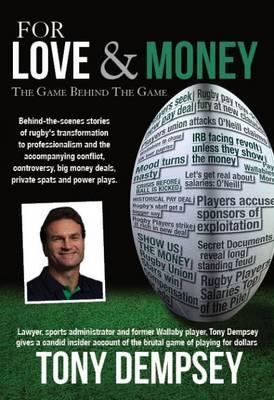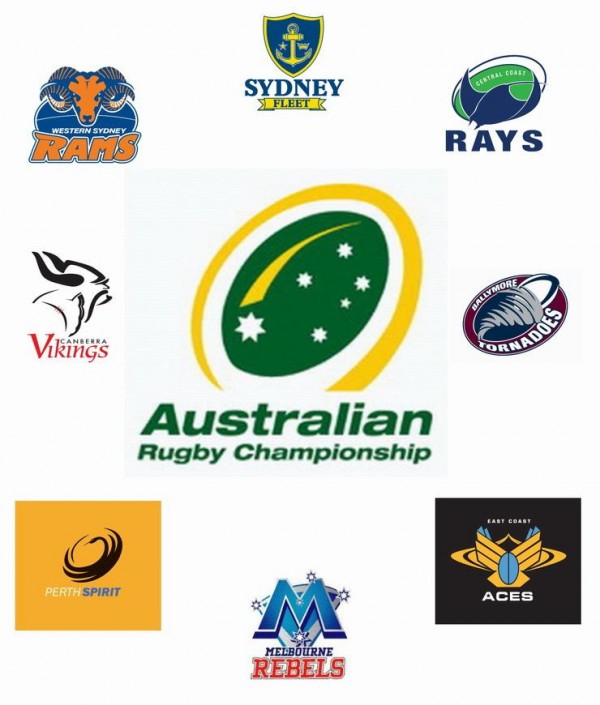For Love and Money: The game behind the game is a new book authored by Tony Dempsey. It tells the ‘behind the scenes’ stories of some of the more significant battles between the ARU  administration and the players as the game of Rugby has battled with professionalism this last two decades.
administration and the players as the game of Rugby has battled with professionalism this last two decades.
Dempsey, for those who are not aware, is a former Waratah forward, circa early 1990s who went on a Wallaby tour in 1993. More significantly, and of more relevance to this book, Dempsey was the inaugural CEO of RUPA –the Rugby Union Players Association and was intimately involved in the shaping of the game, on behalf of the elite players, when the game went professional in the mid ‘90s. Along the way he took on the ARU around World Cup bonus payments, player rights protection, leaguies, etc.
Let’s get the review out the way. The book’s an interesting read. Not riveting, but provides a decent insight into one side of the professionalism of rugby. In honesty, Peter FitzSimons’ book “The Rugby War” does provide a more rounded account of the game’s ascent (decent?) into professionalism. This book covers a broader period, but comes across more a memoir as Dempsey recounts his career, and then his involvement in what are some of the more significant moments of this game’s recent history.
It would have been great to get some of the differing perspective on some of those matters, as in the end all we have is Dempsey’s side of the story with some well selected media clippings. What is clear is that Dempsey is a rather strong willed individual. What is also clear is that he damn well needed to be when he went up against former ARU CEO John O’Neill. These two butted heads big time. Over everything.
Reading this book at a time when the sport is seemingly on the brink of bankruptcy provides an interesting juxtaposition. The whole genesis of RUPA was when rugby went pro and all of a sudden both the ARU and the players were had to ready themselves for a sudden influx of money. Dempsey raves about how he was able to get the best for the players and how their playing conditions, under the CBA, was world-class and indeed industry leading.
Flash forward to now and where do we stand? The players are pretty much in the same boat. Getting paid puh-lenty, despite an agreed pay reduction this year! They remain bloody well supported by RUPA as well via the various iterations of their original Collective Bargaining Agreement.
But how is the ARU faring, and indeed the sport in Australia in general? Both are struggling big time. The ARU is borderline broke, so we hear. So much so they are asking their grassroots clubs across the country to bail them out through a direct cash levy of $200 per team. Four out of the five Super Rugby codes are in a similar boat. Whilst other codes are signing record TV rights deals, we are struggling to sell tickets to the Bledisloe Cup.
And this makes me angry. Ok fine. Dempsey and RUPA were doing what they were there to do. Look after the players. But bugger me, who was looking out for the game itself? The battle between the players and the ARU back in 1995 was whether the players would receive 100% of the News Corp investment into the game, or 95%. They actually kicked up a stink when at one stage it was mooted that they only get 90% of the $13million ($14.5m the second year, $15.5m the third year etc).
Remember that at this time, it was just the players (represented by Dempsey and Tim Kava majorly) up against the still amateur ARU (no JON yet). The ARU were the ones under the pump here and the players held all the cards. Super League was throwing around telephone numbers as salary offers and the ARU didn’t want to lose their stars. Dempsey and RUPA were in the prime negotiation position and used it to their advantage. Good for them.
I guess.
But what if….

What if there was a moment where they all thought for the future of the game itself? What if instead of wanting to split a little over $12million amongst the 90 odd professional players (remembering there were only the Reds, Tahs and Brumbies back then), RUPA and the ARU were able to decide the game needed future proofing?
Bugger it. Give the players 70%. That would have equated to an approximate average salary of just over $100k per year for them all. Down about $30k a year, but still bearable right?
Let’s leave the ARU 15% (rather than the 5% stipulated by RUPA) to go to junior development – a handy $1.95million that first year, again increasing every year.
Then, what if someone thought – “hey, we’ve got some bloody good players at the moment. And gee they are worth getting paid a few hunjie a year for sure. Others perhaps not so, and others still will be perhaps worth that in a few years’ time.”
“But where are we going to get more of these players? Clubs? Perhaps, but park footy is barely sustainable in its own right.”
“Hey! I know! Perhaps we should set up some form of competition like, you know, New Zealand has? Or maybe South Africa? A national provincial competition to help bridge the gap between amateur club rugby and the professional game.”
Demspey reveals that JON had some proposal sitting in his desk through the late 90s advocating the creation of this elusive ‘third tier’, but failed to act on it. If true, this pisses me off no end.
I know this article stinks of 20/20 hindsight, but it just disappoints me so much that there seems to have been no consideration to such future proofing of the game back then. The ARU were the ones that should have been pushing it but as mentioned above, their focus was on signing their players so they could deliver on the new Super 12 tournament they had agreed to with News Corp and their SANZAR partners.
As I said, kudos to Dempsey and his team on getting a great deal for the players, but his gloating throughout this book is a little hard to take given the current state of the game. He did what he had to do at the time to get the best deal for the players, as he states was his goal. Unfortunately an opportunity was missed to protect the future of the game.
After all, the game will remain without the players but the players won’t remain without the game.
Maybe I’m wrong and my assertions are misplaced. I’m sure there is somebody out there who can tell me so, perhaps in the comments below. Clearly this book fired up some form of reaction from me. Have a read yourself and let us know what you think.

